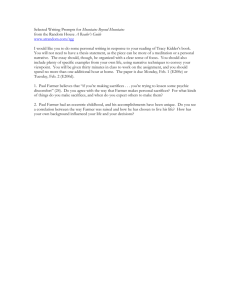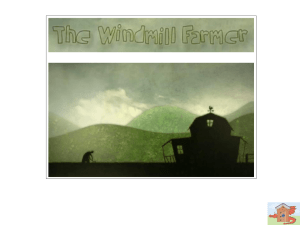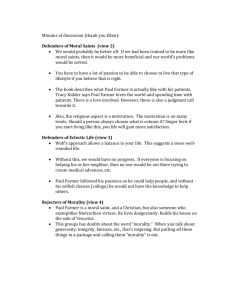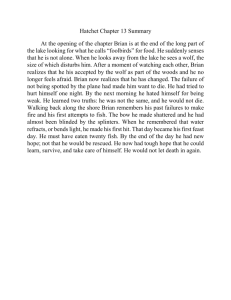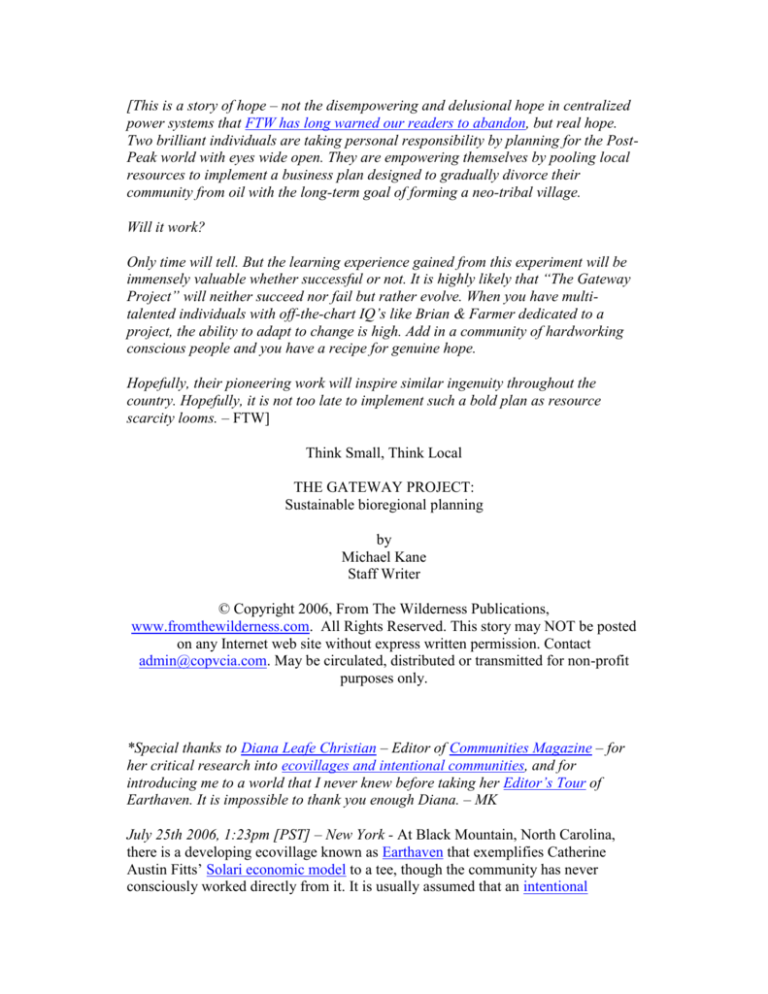
[This is a story of hope – not the disempowering and delusional hope in centralized
power systems that FTW has long warned our readers to abandon, but real hope.
Two brilliant individuals are taking personal responsibility by planning for the PostPeak world with eyes wide open. They are empowering themselves by pooling local
resources to implement a business plan designed to gradually divorce their
community from oil with the long-term goal of forming a neo-tribal village.
Will it work?
Only time will tell. But the learning experience gained from this experiment will be
immensely valuable whether successful or not. It is highly likely that “The Gateway
Project” will neither succeed nor fail but rather evolve. When you have multitalented individuals with off-the-chart IQ’s like Brian & Farmer dedicated to a
project, the ability to adapt to change is high. Add in a community of hardworking
conscious people and you have a recipe for genuine hope.
Hopefully, their pioneering work will inspire similar ingenuity throughout the
country. Hopefully, it is not too late to implement such a bold plan as resource
scarcity looms. – FTW]
Think Small, Think Local
THE GATEWAY PROJECT:
Sustainable bioregional planning
by
Michael Kane
Staff Writer
© Copyright 2006, From The Wilderness Publications,
www.fromthewilderness.com. All Rights Reserved. This story may NOT be posted
on any Internet web site without express written permission. Contact
admin@copvcia.com. May be circulated, distributed or transmitted for non-profit
purposes only.
*Special thanks to Diana Leafe Christian – Editor of Communities Magazine – for
her critical research into ecovillages and intentional communities, and for
introducing me to a world that I never knew before taking her Editor’s Tour of
Earthaven. It is impossible to thank you enough Diana. – MK
July 25th 2006, 1:23pm [PST] – New York - At Black Mountain, North Carolina,
there is a developing ecovillage known as Earthaven that exemplifies Catherine
Austin Fitts’ Solari economic model to a tee, though the community has never
consciously worked directly from it. It is usually assumed that an intentional
community such as this is a commune, but that is not so in the case of Earthaven.
Instead, what I will call a “natural-capitalist” model has been embraced where
investment in the community is encouraged through equity. One community member
calls this “capitalism with a heart.”
Within this community, two individuals have taken the initiative to fast-forward
Earthaven’s planning for the Post-Peak world by implementing an amazingly
ambitious business plan with a bioregional focus. Chris Farmer and Brian Love
(commonly referred to as “Brian & Farmer” throughout the community) have raised
$93,000 in loans from Earthaven members for their business. After spending over
five hours with these men in total during my stay at Earthaven, I can tell you this is
where the smart money is.
These low interest loans were given even though Brian & Farmer have no collateral
to back them up--a true testimony to how much trust the community holds in their
ability, intelligence and loyalty. Brian & Farmer’s plan is to integrate as many local
resources as possible: agriculture, livestock, ethanol, bio-diesel, solar energy, wood
gasification, wood milling, aquaculture, and anything else that will help their
community – and hopefully the surrounding communities – survive Post-Peak
through sustainable bio-regional strategies.
The plan starts with a leased agricultural site, a neighborhood, and a project that all
share the same name: “Gateway.”
Earthaven is 320 acres of mountainous forest with few flat areas, so it is difficult to
find sections to clear for agriculture. Since the community is in need of more
farmland, they were able to devise a creative lease structure for Brian & Farmer in
exchange for clearing four acres of relatively flat land provided that they dedicate it
to producing food for Earthaven residents.
Brian (right) & Farmer (left) over-looking their recently cleared land
The 70 year-old forest cleared at Gateway produced massive amounts of lumber that
was locally milled to help create materials for another desperately needed resource at
Earthaven: housing. Brian & Farmer make their income building new houses from
start to finish – foundation, structure, rainwater roof catchment, propane systems,
solar systems, electric systems, interior finishing, etc…
Earthaven is entirely off the electric grid, relying on small-scale solar and microhydro renewable energy systems along with some propane. The community still
relies on economic, food, and hydrocarbon grids, although they are taking steps
everyday to become more self-sufficient. The fact that there is no grid energy makes
it very difficult for a home to be built from scratch in a timely and efficient manner
unless the contractor has an independent source of energy.
Enter The Road Warrior
To deal with this reality Brian & Farmer bought an old U-Haul, converted it to run
on bio-diesel, and installed solar panels with an 800 lb battery and an inverter to
produce all the electricity they need to run their power tools on a construction site.
They affectionately call this beast The Road Warrior.
“98% of the energy we utilize on a construction site is solar, maybe even more,” said
Brian. Occasionally, they have to idle the engine and burn bio-diesel to supplement
the solar panels, but that is extremely rare. The Road Warrior has allowed Brian &
Farmer to virtually corner the construction market at Earthaven. They are currently
booked solid well into 2007.
Bio-fuels
Everywhere you look today the mainstream media is promising us that bio-fuels will
“save” us--save our pocketbooks, save our over-consuming lifestyles, save us from
ourselves. In no way do Brian & Farmer support any of this nonsense, but they are
not abandoning liquid fuels for sustainable bioregional solutions.
They both have a lot of hope for ethanol on a small scale. The “big boys” in this
business are making 200-proof ethanol (pure alcohol), which is extremely energy
intensive to produce. This has made large-scale ethanol production very inefficient.
However, it is only the last 4 to 5% of the process that requires the most energy.
According to Brian – whose knowledge on alcohol production runs deep – producing
190-proof ethanol (95% alcohol) uses only 30 to 40% of the energy needed to make
200-proof ethanol.
So why waste the energy?
Ethanol cannot be alternated in an engine with gasoline unless it is pure alcohol. If
water remains in the ethanol when combined with gasoline (as is the case with 190proof ethanol), these three liquids will separate in your gas tank causing major
problems. Making it 200-proof guarantees that ethanol and gasoline won’t compete
against each other in the transportation fuel market since they can be combined. It
also assures ethanol will always be more expensive to produce than gasoline.
However the conventional automobile can run on 190-proof ethanol alone. All that is
required to do so are three fairly minor tweaks to any car currently on the
road:enlarge the jets on the carburetor or the nozzles on the fuel injector, advance the
timing, and change the material of the fuel line to avoid corrosion if need be.
The long-term goal of The Gateway Project is to have a dedicated fleet of cars –
modified to run on 190-proof ethanol – transporting Earthaven members on
bioregionally produced fuel. The concept is to have a bus or van running on biodiesel that brings people into the nearby city of Asheville where the dedicated fleet
would be stored. Cars, scooters, and bicycles would be left at the homes of friends in
town so everyone could run their errands separately (as is the current paradigm).
A major benefit of this plan is that the number of cars needed in the community
would drastically decrease, saving a significant amount of money and resources. But
there must be a dedicated fleet of cars modified to run on 190-proof ethanol. Any
long-distance trip in one of these vehicles would require bringing all the needed fuel
with you.
At Gateway, Brian & Farmer built a 24’ X 60’ barn constructed with lumber milled
from trees that once stood on the very same land. This is where Brian & Farmer will
house a small ethanol production plant. The corn needed for the process won’t be
grown at Earthaven, but will be produced by local farmers (no more than 15 miles
away) who currently sell their crop to the market. Brian & Farmer plan to offer
above-market pricing to one of these farmers while helping them implement
sustainable organic production of corn (for ethanol) and soybeans (for bio-diesel).
“Organic is not by definition sustainable,” said Brian.
Will local farmers continue to produce corn – which can rapidly deplete soil
nutrients – as Peak Oil wreaks havoc with food security?1 This may be the major
unknown variable currently facing The Gateway Project. Success or failure will
depend on the ability to adapt to change as it arises.
If their ethanol plant is successful, they will also be producing feed for their
livestock from the corn. Ethanol is made from sugar, which is produced from
carbohydrates. The fat, protein and fiber remaining as a byproduct of the brewing
process produces a wet yogurt-like substance that is a highly nutritious feed for
livestock. The “big-boys” have to dry down this distillation grain so it can be
shipped long-distances as commercial animal feed. Both the drying and shipping
process consume energy – lots of it. Brian & Farmer plan to feed their livestock the
“ethanol mash” byproduct of the distillation process without the financial and energy
costs of drying and shipping it.
On the local level it is likely the conservation gained by avoiding these energy
intensive processes while producing the lower-grade 190-proof ethanol will prove
sustainable.
We shall see…2
Wood Gasification
On a large-scale it would be absolutely impossible to utilize wood gasification to
sustain the over-consumption Americans are addicted to. But when you are in a
forest of more than 300 acres that must be partially cleared for agricultural
development and lumber, you are left with tons of chips and brush.
Of course this “waste” has other very important applications such as mulch for
agriculture and filtration for gray-and black-water systems, but the majority is not
consumed in these processes at Earthaven.
“Woodchips are a much lower grade of waste (than the carbohydrates of corn) to
produce fuel from,” asserted Farmer, throwing a few woodchips in my direction as
we stood on a 15-foot mound of them.
Farmer’s interest in this process led him to a farmer in Wyoming who built his own
wood gasification system to supplement his energy consumption on the grid (it spun
his electrical meter backwards). The system was graciously given to Farmer for free
simply because he had such an intense interest in wood gas. When first viewing it in
their barn, I had no clue what the funky looking mechanism could possibly be.
“Looks like something out of a Dr. Seuss book, doesn’t it?” said Farmer with a
glowing grin.
Brian & Farmer don’t know precisely how they are going to use this system most
efficiently within The Gateway Project, but they are certain it will be part of their cogeneration energy system. The wood gas byproduct can also be pressurized in tanks
and used as a propane substitute. The above-pictured generator can run on wood,
gas, or petroleum, but Brian & Farmer plan to replace the petrol aspect with ethanol.
At the very least this system will supplement the energy consumption of their
ethanol plant.3
BIG PICTURE: Plan for the Land
Massive amounts of fertilizer have been spread across the cleared land at Gateway.
Grass and clover are currently growing to fix nitrogen into the soil. Next season
Brian & Farmer plan to start relatively small by growing crops such as sweet
potatoes that require minimal work.
But the long-term goals are far more ambitious.
Using a modified version of Joel Salatin’s rotational grazing method, livestock will
both fertilize and till the land eliminating much of the human labor traditionally
needed to ready the soil for growing vegetables the following season. Animal feed
produced as a byproduct of the ethanol plant will supplement the grazing.
A pond is being developed at the edge of their field where aquaculture will be raised
to provide fish for Earthaven. Waste produced from the slaughter of livestock such
as chicken entrails will be used as feed for the fish.
“Sun fish provide protein in a ratio of 4 to 1, whereas a cow is upwards of 15 to 1,”
explained Brian regarding feed-to-food ratio. The water in the pond may be used as
part of a cooling system for their ethanol plant, which could allow them to include
more warm water fish varieties.
Primal vs. Modern – Grounding the Spell
Obviously things are not perfect with this project just as they are not perfect within
the village itself. There are many differing views and opinions as to what direction
Earthaven should go.
Some want only low-tech solutions and look at Gateway with skepticism, while
others wish the project the best of luck while holding deep doubts regarding the
likelihood of its success. The fact that Brian & Farmer themselves hold the latter
opinion reflects both their humility and the immensity of the task they have assigned
themselves in the face of Peak.
Then there are Gateway’s unabashed supporters:
“I consider the Gateway Project a watershed moment in Earthaven’s history,” said
Diana Leafe Christian on her Editor’s Tour of Earthaven. I tend to agree with this
view since the success of the project is less dependent on whether the details all
come to pass as laid out in this report, but rather on the community’s ability to adapt.
Perhaps most importantly, Gateway will serve as a critical experiment for
transitioning into energy descent. It is nearly impossible for modern Americans to
build shelters in the forest (using no fuel or transportation) resigning to live in
primitive fashion. At the very least Gateway will act as both a mental and physical
bridge on the down slope of Hubbert’s Curve.
However, there are some individuals at Earthaven who can, and often do, survive by
primitive means. A few have argued that everyone in the village should be doing the
same. Brian & Farmer do not feel this is necessary – at least not yet.
“I don’t want to abandon technology or even stop environmental destruction,”
insisted Farmer as he knelt over the finished wood stored on the second floor of his
newly constructed barn. “I want to bear the responsibility for it and bring it out from
behind the veil – see it with my own eyes.”
Farmer repeatedly described the process of clearing over four acres of forest as
“brutal.” Using massive machinery to uproot tree after tree was neither easy nor
without emotional scars, according to Farmer. He doesn’t believe anyone could buy
a 2X4 from Home Depot if they had to witness the forest being clear-cut to produce
it day after day. For these two men technology itself is not the problem, but rather it
is the way we have chosen to utilize technology that is both tragic and perverse. Now
that Brian & Farmer have consciously decided to dominate the land and resources
they call Gateway, it is their responsibility to be proper stewards with good
intentions.
There are those at Earthaven who feel that a strict definition of “sustainable building
practices” should be adhered to; that means no formaldehyde-soaked plywood,
sheetrock, or many of the other modern construction materials commonly used to
build homes. Timber-framed and adobe brick homes are commonly seen throughout
the village. But when is sustainable building not sustainable? “When you’re not
growing your own food,” says Farmer.
If it takes 10 years to build your “sustainable” home, yet you have to drive into town
to buy food shipped in from California, how sustainable is that? Rough (very rough)
estimates given to me regarding how much of Earthaven’s produce is currently
grown on site were around 5% during the growing season. This drops drastically in
the winter. Everything must be done at once, fast. Brian and Farmer are using every
resource available to them in a race against Peak.4
“We really needed to start all of this 10 years ago,” said Farmer.
It Takes a Village
There are many individual leaders throughout Earthaven in addition to Brian &
Farmer showing initiative in many critical areas for the greater community.
It is my pleasure to report that a large percentage of people at Earthaven not only
know what Peak Oil is, but they also fully grasp a vast number of the “what if”
scenarios we need to be thinking about and preparing for at this point in time. During
my stay, Patricia Allison, a longtime Earthaven member and fifteen-year
Permaculture veteran, screened the final edit of “The Power of Community”
detailing how Cuba dealt with their own energy crisis. The conversation engaged in
after the screening was both encouraging and realistic.
It was also extremely heartwarming, on a personal level, to see how many FTW
supporters there are at Earthaven – Brian & Farmer being among the top of that list.
To know that informed individuals actively pursuing sustainability are reading our
publication is the ultimate compliment we as an organization can receive.
To everyone that I met at Earthaven: Diana, Rosetta, Farmer, Brian, Jason, Cailan,
Lee, Jeff, Sue, Joe, Andy, Julie, Ivy, Shawn, Holly, Eli, Josh, Patricia, Tracy,
Benton, Dan, Greg, Chuck, Arjuna, Tanya, Robert, Michael Jon, Aiden, Peggy,
Marjorie, Gigi, Natasha, Elise, Cynthia, Paul, Mark, Max, Brandon, Corinna, Willow
and the rest of the extended family of guests, work exchangers and friends – you all
exemplify what humans are truly capable of at our best. FTW will be keeping an eye
on this truly revolutionary community and The Gateway Project.
1
Earthaven inherited degraded soil from Appalachian farmers who grew corn almost
exclusively before leaving the land. The soil is mostly clay, and community
members are using a variety of techniques to bring fertility back to their soil.
However the clay is a valuable resource for building adobe brick housing.
2
Throughout the country people are using vegetable oil as liquid fuel. At the Sirius
ecovillage in Shuttesbury, Massachusetts, they are quite proud of their “french fry
bus” that runs on used vegetable oil from fast food restaurants in town. Perhaps this
is a nice recycling concept, but I doubt there is any need to describe how
unsustainable this fuel model will be Post-Peak.
3
During World War II the Nazis required the populations they conquered to convert
their cars to wood gas due to the short supply of oil and gasoline desperately needed
for the war machine.
4
A well-known Peak Oil activist has already moved into a post-oil paradigm. He has
no car. He has no cell phone. He travels only by train to avoid leaving a large
energy footprint. Yet at the same time he tries to organize conferences around the
country, leaving people who depend on quick responses and decision making to
operate at levels not seen since the 1940s or 50s.
Does anyone here believe that Dick Cheney or Hillary Clinton or Fed Chairman Ben
Bernanke or any of the world’s business leaders are making such self-sabotaging
choices now? They may have to, someday. But for now they are taking every possible
advantage, using whatever energy is needed, to prepare and position themselves to
stay ahead of what are now certain coming events.
I hate to say it, but perhaps we should take a lesson from our enemies here.
Let us not forget that in order to get to the Post-carbon world that is inevitable we
must first survive the collapse and the die off that is inevitable. The challenges of the
transition period will be completely different from the challenges of living in a world
without cheap energy.
It is the almost complete failure of the Peak Oil movement in the United States—and
around the world—to grasp, ponder or even acknowledge these transitions that are
pointing to a needed evolution in our approach to education, research, networking,
and organizing. Psychologically it is always easier to plan along the lines of a single
challenge rather than to try to prepare for chaos on a fluid, multi-dimensional field
where serious challenges may be completely different from one day to the next. But
the easiest path is not always the best choice.
The maxim that I live by is that what we need today, right now, is not a plan, but
options. Plans do not bend well. They tend to break. And with breaks in plans come
break downs in function. The only plan that I live by today—the only plan that I
recommend to our subscribers—is to increase one’s options as much as possible and
to selectively choose those options based upon what is happening in the world now
and what those developments might mean for the future.
I would submit to you tonight that perhaps a more important question that needs to
be answered first is: “How do we get from a civilization where collapse and
dislocation is just beginning to a place where we can prepare to transition away
from oil and gas when the time is appropriate”? [emphasis added]
Mike Ruppert, April 29, 2006, in a speech delivered at the Local Solutions to the
Energy Dilemma Conference in NYC
http://www.fromthewilderness.com/free/ww3/042706_paradigm_speech.shtml



